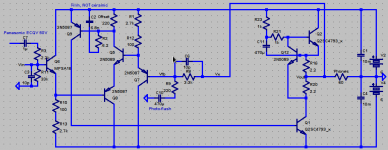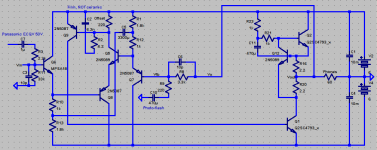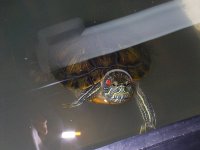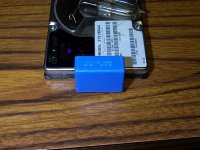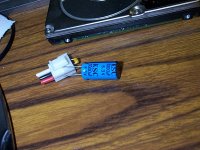The Mylar seems to sound less harsh. Not sure whether this is good or bad. Not sure how the source is supposed to sound.
These most recent changes are pulling teeth. The MKC seems to be more detailed, with better instrument separation in the midrange, but it's sharp and sometimes irritating. The Mylar in comparison is warm and easygoing. Then again, that MKC came out of a TV from 1979 - can't possibly tell what condition it's in.
The Mylar cap used is the Panasonic ECQ-V series, 50V, 1uF. The MKC is an Ero MKC1863, 1.5uF, 200V.
http://www.panasonic.com/industrial/components/pdf/ef040_ecqv_dne.pdf
I will wait till tomorrow for more tests. I know that when I get tired, all sounds get relatively more irritating and harsh, though I can still compare two and determine which is the harsher.
- keantoken
These most recent changes are pulling teeth. The MKC seems to be more detailed, with better instrument separation in the midrange, but it's sharp and sometimes irritating. The Mylar in comparison is warm and easygoing. Then again, that MKC came out of a TV from 1979 - can't possibly tell what condition it's in.
The Mylar cap used is the Panasonic ECQ-V series, 50V, 1uF. The MKC is an Ero MKC1863, 1.5uF, 200V.
http://www.panasonic.com/industrial/components/pdf/ef040_ecqv_dne.pdf
I will wait till tomorrow for more tests. I know that when I get tired, all sounds get relatively more irritating and harsh, though I can still compare two and determine which is the harsher.
- keantoken
Mylar®, Plastic Sheet, Polyester Film Sheet and Sheet Properties - Grafix Plastics
Mylar is a Dupont brand, I don't think the Panasonic
spec sheet ever specified Dupont Mylar? No doubt
nameless polyester film probably same exact thing.
It could be Mylar, not gonna say for sure it ain't.
Mylar is a Dupont brand, I don't think the Panasonic
spec sheet ever specified Dupont Mylar? No doubt
nameless polyester film probably same exact thing.
It could be Mylar, not gonna say for sure it ain't.
Last edited:
Just listened to my old car amp again, it now sounds primitive in comparison.
I like the mylar/polyester cap better. It's not as detailed or 3D, but it's at least comfortable to listen to. I'm not sure why but it wouldn't surprise me to find out the MKC is damaged somehow.
- keantoken
I like the mylar/polyester cap better. It's not as detailed or 3D, but it's at least comfortable to listen to. I'm not sure why but it wouldn't surprise me to find out the MKC is damaged somehow.
- keantoken
Here is the schematic again, as-built right now.
I should increase C2, it will help into capacitive loads. However I believe an alternative is a small output L||C, which would improve stability without impacting performance at audio frequencies. I favor this option over increasing compensation; a 500nH||22R network improves stability greatly, with hardly an impact on 100KHz phase shift.
- keantoken
I should increase C2, it will help into capacitive loads. However I believe an alternative is a small output L||C, which would improve stability without impacting performance at audio frequencies. I favor this option over increasing compensation; a 500nH||22R network improves stability greatly, with hardly an impact on 100KHz phase shift.
- keantoken
Attachments
Last edited:
I just plugged in the headphones to listen again. I didn't expect it to sound very different with headphones because the speaker emphasizes all distortions, but I believe I'm wrong about that.
It still sounds excellent, even better with headphones. I am very pleased with this amp!
The bass is extremely impressive, to me at least, and especially after adding the photoflash cap. This is a change I highly recommend if you've been using stock electrolytics!
While it sounds very good on speakers, on headphones it is exquisite.
The square wave still shows overshoot, unfortunately. To cure this I will increase C2. Even so... That is the last of my worries, if I can make it unconditionally stable with an L||R as the simulator predicts.
- keantoken
It still sounds excellent, even better with headphones. I am very pleased with this amp!
The bass is extremely impressive, to me at least, and especially after adding the photoflash cap. This is a change I highly recommend if you've been using stock electrolytics!
While it sounds very good on speakers, on headphones it is exquisite.
The square wave still shows overshoot, unfortunately. To cure this I will increase C2. Even so... That is the last of my worries, if I can make it unconditionally stable with an L||R as the simulator predicts.
- keantoken
To paraphrase a family member:
"I don't know what you did, but you did something to bring out the harmony in the voices. I mean, it sounded good before, but...
Is this mono or stereo? [replied mono] Well, for mono it sounds really good. It sounds like I'm in a high balcony, overlooking the orchestra pit, with one big difference - the audience is completely silent"
My brother said he thought something was missing (he was distracted from the music, for a reason he couldn't describe but he said it may just be him), so these two accounts appear to differ. I have to say I agree with the positive review. The positive review came from someone who gets a headache from any shrill noises (bad sound systems, diesel engines, certain notes)
Neither of these have been exposed to real "hifi", and aren't obsessive about music, so I consider them relatively neutral.
- keantoken
"I don't know what you did, but you did something to bring out the harmony in the voices. I mean, it sounded good before, but...
Is this mono or stereo? [replied mono] Well, for mono it sounds really good. It sounds like I'm in a high balcony, overlooking the orchestra pit, with one big difference - the audience is completely silent"
My brother said he thought something was missing (he was distracted from the music, for a reason he couldn't describe but he said it may just be him), so these two accounts appear to differ. I have to say I agree with the positive review. The positive review came from someone who gets a headache from any shrill noises (bad sound systems, diesel engines, certain notes)
Neither of these have been exposed to real "hifi", and aren't obsessive about music, so I consider them relatively neutral.
- keantoken
Another thing about my brother, when I think it sounds good he always thinks "it's missing something..." and vice-versa.
So apparently you can't please everyone (at least I didn't).
- keantoken
So apparently you can't please everyone (at least I didn't).
- keantoken
Just letting you know you're not in a vacuum, I've been watching your progress. I'm in the middle of two different headphone amp prototypes; one using just one tube (6s45p-e) and output transformer, and the other my hybrid design with the 1s4 tube. But I hope to go back and give your amp another shot, when I'm done with mine.
Thanks for breaking my heptapost Iko!
If so, it will be interesting to see a comparison of the two, by someone with more experience than me.
- keantoken
If so, it will be interesting to see a comparison of the two, by someone with more experience than me.
- keantoken
Capacitor Woes
There was audible hum at first, and I realized this was because the H2 generator was removed, and no longer providing the benign side-effect of increasing PSRR by filtering the bias network. To fix this, I decided to add a filter cap across the H2 generator break points. However, simulation confirmed that due the the low 100 ohm resistors, HF operation would be affected, and the last thing I want in the compensation path is a bulky electrolytic capacitor. So I increased the 100R resistors to 1k, which works well enough.
On the way, I realized I was not using a 6.8nF compensation cap as I had thought, but actually a 68nF cap! Oh the humanity! Oops... I just replaced it promptly with a 6.2nF cap, and will audition shortly.
Here is the new prototype.
- keantoken
There was audible hum at first, and I realized this was because the H2 generator was removed, and no longer providing the benign side-effect of increasing PSRR by filtering the bias network. To fix this, I decided to add a filter cap across the H2 generator break points. However, simulation confirmed that due the the low 100 ohm resistors, HF operation would be affected, and the last thing I want in the compensation path is a bulky electrolytic capacitor. So I increased the 100R resistors to 1k, which works well enough.
On the way, I realized I was not using a 6.8nF compensation cap as I had thought, but actually a 68nF cap! Oh the humanity! Oops... I just replaced it promptly with a 6.2nF cap, and will audition shortly.
Here is the new prototype.
- keantoken
Attachments
Square wave tests mostly the same, I think even better.
Cymbals and upper midrange are MUCH better, instrument separation has also increased a lot. Highs are sharp but not fatiguing.
This is the initial impression listening to the speaker, but I will test out headphones later and see if the hum is resolved as the scope suggests. I could also actually hear pixels changing on my monitor... Weird (maybe the new soundcard?)
- keantoken
Cymbals and upper midrange are MUCH better, instrument separation has also increased a lot. Highs are sharp but not fatiguing.
This is the initial impression listening to the speaker, but I will test out headphones later and see if the hum is resolved as the scope suggests. I could also actually hear pixels changing on my monitor... Weird (maybe the new soundcard?)
- keantoken
I don't recommend using a very large value for C3 because the bias will take several seconds to settle. I recommend 470uF at most.
- keantoken
- keantoken
Offset has never gone farther than 5mV, most always staying within 2mV. If I am to believe Tangentsoft, this is good enough for headphones (it hasn't damaged mine as far as I am aware):
Input Capacitors for Headphone Amps
I have been experimenting with a mechanical pocketwatch lately. My ears are more sensitive when I'm sad. The sensitivity depends mostly on my emotional state. It ticked obnoxiously loud on the day I missed the chat with a friend... When I'm enjoying myself or I try to focus on the sound of the watch, I can no longer hear it. If I'm careful, I can hear the watch 10 feet away (on the other side of the room). My current theory is that mental activity dulls the ears' sensitivity. Thus, after certain shocks when the mind is quiet and not conspiring, I can hear the pocketwatch without having to concentrate.
Complementary turtle foto. No, the water isn't that murky, the camera flash makes it look bad.
- keantoken
Input Capacitors for Headphone Amps
I have been experimenting with a mechanical pocketwatch lately. My ears are more sensitive when I'm sad. The sensitivity depends mostly on my emotional state. It ticked obnoxiously loud on the day I missed the chat with a friend... When I'm enjoying myself or I try to focus on the sound of the watch, I can no longer hear it. If I'm careful, I can hear the watch 10 feet away (on the other side of the room). My current theory is that mental activity dulls the ears' sensitivity. Thus, after certain shocks when the mind is quiet and not conspiring, I can hear the pocketwatch without having to concentrate.
Complementary turtle foto. No, the water isn't that murky, the camera flash makes it look bad.
- keantoken
Attachments
I think the new MKC cap by far sounds the best.
It looks like everything's set for until I get the parts to build the prototype.
I will need a set of 4 2SC4793's, 4 5pF silver micas (so I can test 5p-10pF values for feedback and input caps).
Attached is one of the caps I was originally using for the feedback DC blocker. When I tested ESR of several caps, I found to my surprise that this one had amazingly low ESR for it's size. Usually smaller caps have higher ESR. So big cans might have high ESL but still have VERY low ESR. These can be gotten out of "Glade Wisp" air fresheners. I harvested this one so I would have a stereo pair, to be used for C5.
- keantoken
It looks like everything's set for until I get the parts to build the prototype.
I will need a set of 4 2SC4793's, 4 5pF silver micas (so I can test 5p-10pF values for feedback and input caps).
Attached is one of the caps I was originally using for the feedback DC blocker. When I tested ESR of several caps, I found to my surprise that this one had amazingly low ESR for it's size. Usually smaller caps have higher ESR. So big cans might have high ESL but still have VERY low ESR. These can be gotten out of "Glade Wisp" air fresheners. I harvested this one so I would have a stereo pair, to be used for C5.
- keantoken
Attachments
Last edited:
I readjusted compensation, I'm learning better how do do just that.
To paraphrase my brother in less words:
"Sense of air, sense of space, good separation, sounds very stereo, very clear sound, not stuffy or muffled. It sounds like there is no speaker, just a window, and music flowing into the room."
- keantoken
To paraphrase my brother in less words:
"Sense of air, sense of space, good separation, sounds very stereo, very clear sound, not stuffy or muffled. It sounds like there is no speaker, just a window, and music flowing into the room."
- keantoken
- Status
- Not open for further replies.
- Home
- Amplifiers
- Headphone Systems
- Rush Cascode Headphone Amp + JLH Output Stage
